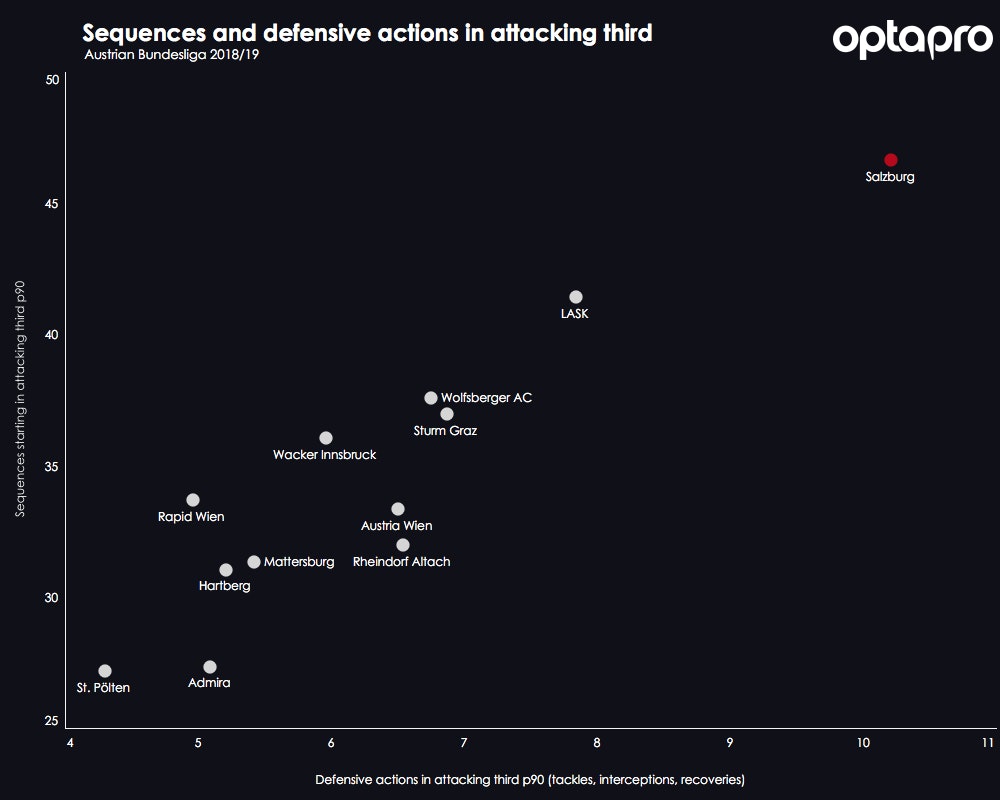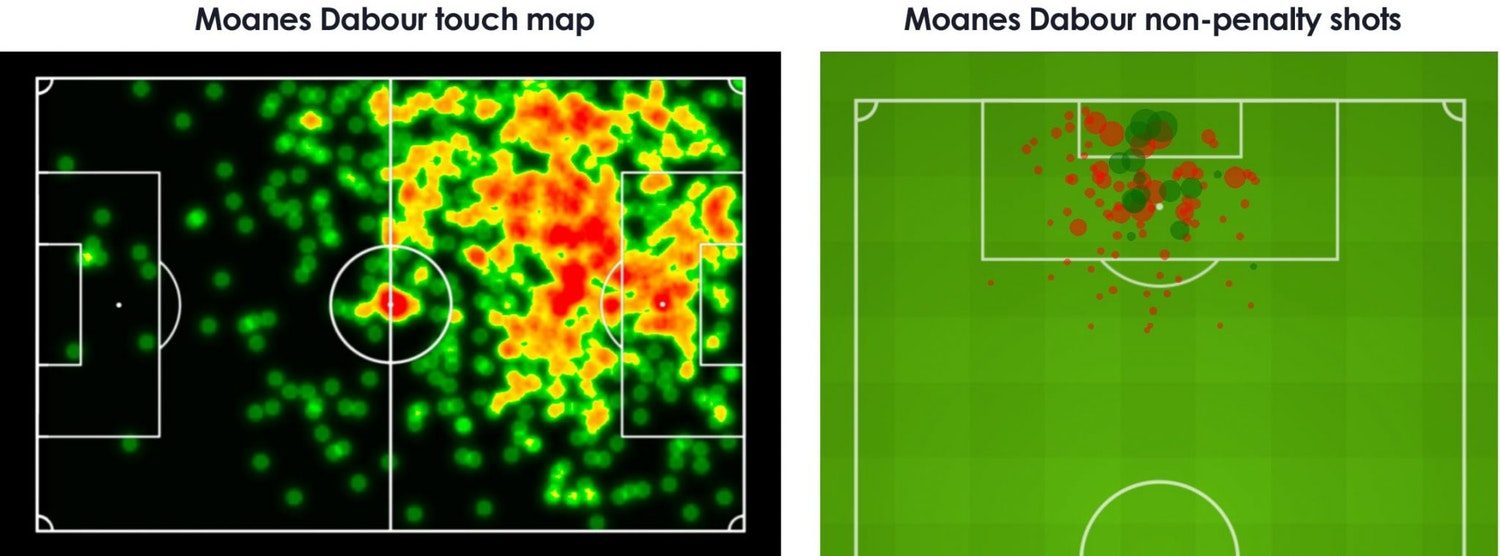Key takeaways
– In the attacking third, Salzburg have started the most sequences and recorded the most defensive actions of any Bundesliga team, emphasising their high press.
– Their first-choice full backs are heavily involved offensively and have contributed a combined 8.9 xA this season.
– Leading scorer Moanes Dabour’s Shooting Goals Added (SGA) since the start of 2017/18 is 5.86, reinforcing his ability to put away goalscoring chances.
Despite losing three key players last summer, Red Bull Salzburg remain on course to secure their sixth successive Bundesliga title with eight matches left to play.
After recouping €45 million on Duje Caleta-Car, Amadou Haidara and their leading chance creator last year, Valon Berisha, the club continued its policy of investing in youth by bringing in several players under 21 last summer, supplemented by the experienced Zlatko Junuzovic as a replacement for Berisha in midfield.
The dominance of their youthful squad, which includes seven players under 21 who have featured in at least 30% of all available league minutes, is reflected in the fact that they have created 13.4 chances per 90 from 24 Bundesliga games (for context, Manchester City have created 13.7 in the Premier League) and their average possession per game is 63.8%.
In this blog, we are going to take a closer look at Salzburg’s approach this season and the strategies they have adopted to overcome opposition who often sit deep looking to deny them space.
Successfully executing a high press
One area which highlights how Salzburg are denied space is the fact that 37% of all their goal attempts have occurred from outside the box, which is the second highest proportion in the league. Only eight of their 159 long-range efforts have resulted in a goal.
Given how they are allowed to have the ball, it will be no surprise to know that they lead the league in terms of average number of sequences per game and time per sequence, with the slowest direct speed. They also average 34.2 sequences of 6 or more passes per 90, substantially more than any other Bundesliga team.
However what is more significant is the fact that their average sequence starts 50.8 metres from their goal line, which indicates that they look to win the ball back high up the pitch. More than 26% of all their sequences start in the attacking third – 46.6 per 90.
These figures are backed up by the number of their defensive actions (tackles, interceptions and recoveries) in the attacking third compared to the rest of the league.

At player level, attacking midfielder Hannes Wolf is the player contributing the most defensive actions. The teenager typically plays at the top of Salzburg’s midfield diamond and averages 2.53 per 90, looking to win the ball back to feed Moanes Dabour or their attacking-minded full backs in wide areas.
Penetrating down the wings
Salzburg’s two full-backs, Andreas Ulmer down the left and Stefan Lainer down the right, are involved at the heart of their side’s offensive play.
Salzburg’s use of width is highlighted by the fact that they average 20.96 crosses per 90, the highest in the league, with the full backs delivering over half of them. They both average over 28 touches per 90 in the attacking third, ranking them in the top 15 for full backs across top-flight European leagues.
The quality of the chances they create is reflected in their xA respective outputs – Ulmer has 5.04 and Lainer 3.86 this season.

Salzburg are particularly threatening down the left-hand side, with Ulmer and Junuzovic creating a combined 76 chances between them this season.
To create space down this side, they also possess a right-sided centre back in André Ramalho who is very adept at switching play accurately, as highlighted by the pitch map below. The Brazilian’s passing accuracy for long balls into the attacking half is 59%, with his second most common target being Ulmer, as they look to stretch the opposition.

A clinical front man
Since joining Salzburg two years ago, Moanes Dabour has been prolific in front of goal, averaging 0.81 goals per 90.
The Israeli forward has enjoyed the best xG output in Bundesliga by some margin this season and the quality of his finishing is reflected by the fact that his Shooting Goals Added (SGA) since the start of 2017/18 is 5.86, which reflects how the probability of his goal attempts increase based on the end location of his shots compared to where they were struck. More information on SGA can be found here.
Whilst nearly all of Dabour’s goal attempts occur in central areas inside the box, he is by no means a static front man. In open play he frequently drifts out into areas on the left-hand side, where he links up with Ulmer and Junuzovic. In total he has created 21 chances this season and his xA of 3.07 is the fourth highest in Salzburg’s squad.

Another busy summer ahead
The quality and accuracy displayed by Salzburg’s attacking players is reflected in the fact that despite recording more shots than any other team, they still have the best shot conversion rate in Bundesliga (13.4%), with over 40% of attempts ending up on target.
However as was the case last year, they will be losing two of their key players at the end of the season, with Wolf and Dabour moving to Leipzig and Sevilla respectively.
Salzburg have already been active in the transfer market, bringing in Norwegian striker Erling Håland in January, who was profiled here in an earlier blog. They also have Smail Prevljak waiting in the wings, who has scored nine goals this season.
Whilst losing important players has been a regular occurrence for Salzburg since 2014, the club has still been able to maintain their dominance domestically whilst also reaching the knockout stages of European competition, suggesting they have a strong succession plan in place.
Based on recent evidence, you would not bet against them successfully reinventing themselves again and continue this dominance into 2019/20 and beyond.